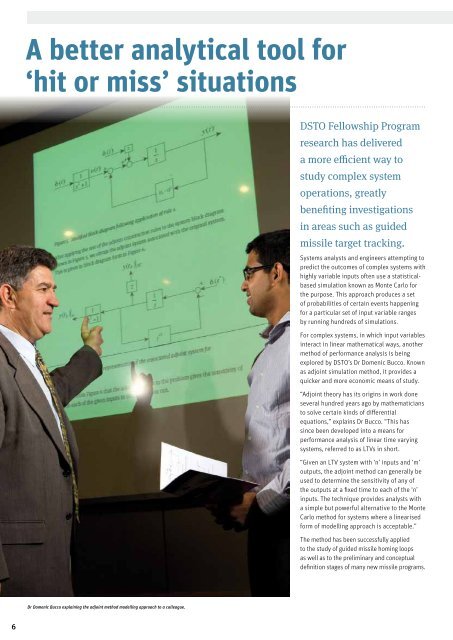DSA Volume 1 Issue 4 December 2010 - Defence Science and ...
DSA Volume 1 Issue 4 December 2010 - Defence Science and ...
DSA Volume 1 Issue 4 December 2010 - Defence Science and ...
Create successful ePaper yourself
Turn your PDF publications into a flip-book with our unique Google optimized e-Paper software.
A better analytical tool for<br />
‘hit or miss’ situations<br />
DSTO Fellowship Program<br />
research has delivered<br />
a more efficient way to<br />
study complex system<br />
operations, greatly<br />
benefiting investigations<br />
in areas such as guided<br />
missile target tracking.<br />
Systems analysts <strong>and</strong> engineers attempting to<br />
predict the outcomes of complex systems with<br />
highly variable inputs often use a statisticalbased<br />
simulation known as Monte Carlo for<br />
the purpose. This approach produces a set<br />
of probabilities of certain events happening<br />
for a particular set of input variable ranges<br />
by running hundreds of simulations.<br />
For complex systems, in which input variables<br />
interact in linear mathematical ways, another<br />
method of performance analysis is being<br />
explored by DSTO’s Dr Domenic Bucco. Known<br />
as adjoint simulation method, it provides a<br />
quicker <strong>and</strong> more economic means of study.<br />
“Adjoint theory has its origins in work done<br />
several hundred years ago by mathematicians<br />
to solve certain kinds of differential<br />
equations,” explains Dr Bucco. “This has<br />
since been developed into a means for<br />
performance analysis of linear time varying<br />
systems, referred to as LTVs in short.<br />
“Given an LTV system with ‘n’ inputs <strong>and</strong> ‘m’<br />
outputs, the adjoint method can generally be<br />
used to determine the sensitivity of any of<br />
the outputs at a fixed time to each of the ‘n’<br />
inputs. The technique provides analysts with<br />
a simple but powerful alternative to the Monte<br />
Carlo method for systems where a linearised<br />
form of modelling approach is acceptable.”<br />
The method has been successfully applied<br />
to the study of guided missile homing loops<br />
as well as to the preliminary <strong>and</strong> conceptual<br />
definition stages of many new missile programs.<br />
Dr Domenic Bucco explaining the adjoint method modelling approach to a colleague.<br />
6

















